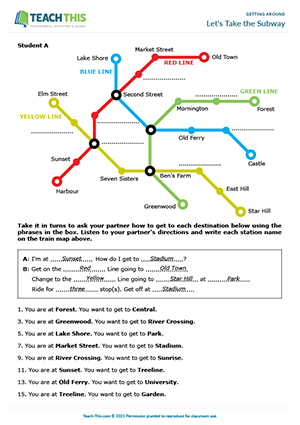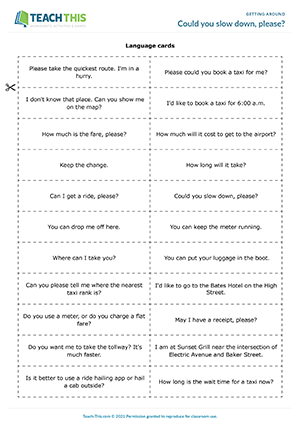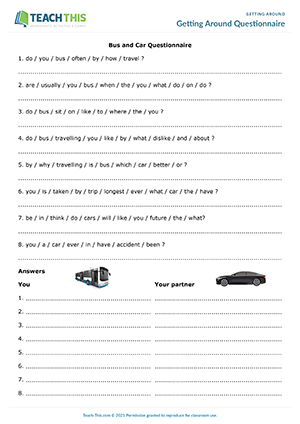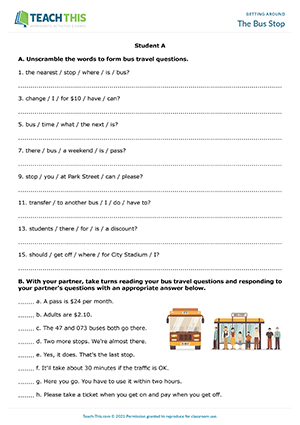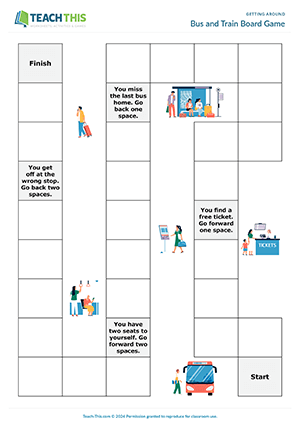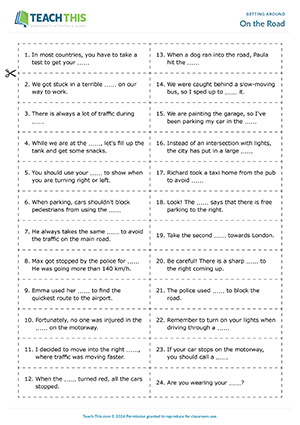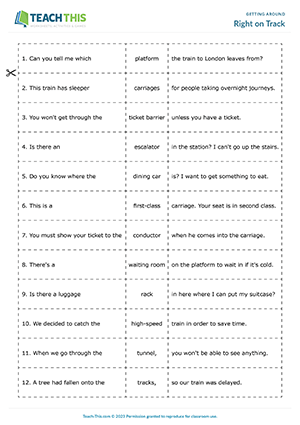In this free subway travel activity, students practice asking for and giving directions using a subway system map to help them learn language for getting around on a train or subway. In pairs, students take turns asking for and giving directions from one subway station to another using a subway system map and language from a box. Students listen to their partner's directions, follow them, and write the destination station name on their map. Afterwards, students check their answers by comparing maps with their partner.
In this engaging train travel role-play activity, students ask and answer questions about rail travel information and practice booking train tickets. In pairs, one student takes on the role of a traveller going on a train journey with a friend. Their task is to find out train travel information and book tickets. The other student is a train station ticket agent. Their task is to answer questions and help book tickets. The traveller explains to the ticket agent which train they want to catch, when, and for how many people, and asks for information to complete sentences on their worksheet and book the tickets. The ticket agent uses the information on their worksheet to tell the traveller about the various train times, platform numbers and ticket prices. When the role-play has been completed, the two students swap roles, giving both students a chance to use the language for each role and to confirm the answers. Lastly, pairs role-play the situation in front of the class.
In this useful taxi language game, students race to match language with taxi-related situations. In pairs, students take turns turning over a situation card and reading out the taxi-related situation. Both students then race to find the appropriate taxi language card that corresponds to the situation. The first student to find the card, say the sentence, and place it on top of the situation card wins and keeps the cards. The student with the most pairs of cards at the end of the game wins.
In this insightful travel questionnaire activity, students form travel questions about different forms of local transport and then ask and answer the questions with a partner. First, in two groups, students put words in the correct order to form questions about getting around by taxi and train or car and bus. Next, students read the travel questions and write down their answers. Students then pair up with someone from the other group and take turns asking their partner the questions, noting down their answers, and asking follow-up questions to gain more information. Finally, students tell the class what they found out about their partner.
In this creative taxi vocabulary game, students match words related to travelling by taxi with their definitions and then try to make a sentence a passenger or taxi driver would say using the word. In pairs, students take turns turning over one taxi-related word card and one definition card and reading them aloud. If the word or phrase matches with the definition, the student keeps the two cards and scores a point. The student then tries to make a sentence a passenger or taxi driver would say using the word or phrase on the card for an extra point. If the student is able to do this, they have another turn. If the cards don't match, the student turns them back over. The student with the most points at the end of the game wins.
In this free bus travel activity, students practice asking and answering questions related to taking the bus. First, in two groups, students unscramble words to form bus travel questions. Next, students pair up with someone from the other group. Students then take turns asking the bus travel questions to their partner, who responds with an appropriate answer from their worksheet, writing the corresponding question number next to the reply. Finally, check the correct answers with the class. As an extension, students use the questions to create a bus travel dialogue that they present to the class.
In this productive bus and train board game, students practice vocabulary related to bus and train travel. In groups, students take turns picking up a card and asking the player to their right a bus or train-related multiple-choice question. The player then guesses which of the three answers is correct. If the player's guess is correct, they roll the dice and move their counter along the board. If not, the player doesn't roll the dice. The first player to reach the finish wins the game.
Here are two useful driving vocabulary games that help students practice words related to driving. Students begin by playing a pelmanism game to practice the driving vocabulary. In pairs, students take turns turning over one gap-fill sentence card and one driving word card. If the driving word completes the sentence, the student reads the sentence aloud, keeps the two cards, and plays again. If the driving word and sentence don't match, the student turns the two cards back over. The student with the most pairs of cards at the end of the game wins. After that, students play a game in which they make sentences using the driving vocabulary. Students take turns picking up a vocabulary card and reading the driving word to their partner, who has 20 seconds to make a meaningful sentence with the word. If the student is able to make a sentence, they win and keep the card. If not, the card is placed at the bottom of the pile. The student with the most cards at the end of the game wins.
Here is a fast-paced train travel vocabulary game to help students practice language related to travelling by train. In pairs, students race to line up sentence beginning cards and match each one with a suitable ending card. When pairs have lined up all their sentences, they complete the sentences by joining the sentence halves together with train travel word cards. The first pair to correctly complete all their sentences wins the game.
Latest Free
Resources
- Jigsaw Reading
Reading Exam Preparation (B1)
Date Added: 7th of March
- Writing Jeopardy
Writing Exam Preparation (B1)
Date Added: 6th of March
- Present Perfect Bingo
Present Perfect Yes No Questions (A2)
Date Added: 4th of March
- Count on Me!
Making Offers and Promises (A2)
Date Added: 11th of February
- It’s Carnival Time!
Cultural Celebrations (B1)
Date Added: 29th of January
Latest Member
Resources
- Shops and What They Sell
Shopping (B1)
Date Added: 12th of March
- Who has written this?
Present Perfect Yes No Questions (A2)
Date Added: 11th of March
- Business Greetings and Introductions
Networking (B2)
Date Added: 11th of March
- Have you done this?
Present Perfect Yes No Questions (A2)
Date Added: 7th of March
- True, False or Not Given
Reading Exam Preparation (B2)
Date Added: 7th of March



